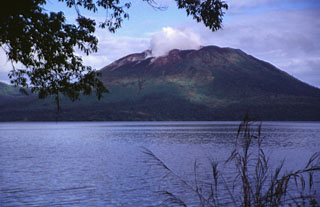Report on Gaua (Vanuatu) — 24 September-30 September 2025
Smithsonian Institution / US Geological Survey
Weekly Volcanic Activity Report, 24 September-30 September 2025
Managing Editor: Sally Sennert.
Please cite this report as:
Global Volcanism Program, 2025. Report on Gaua (Vanuatu) (Sennert, S, ed.). Weekly Volcanic Activity Report, 24 September-30 September 2025. Smithsonian Institution and US Geological Survey.
Gaua
Vanuatu
14.281°S, 167.514°E; summit elev. 729 m
All times are local (unless otherwise noted)
The Vanuatu Meteorology and Geohazards (VMGD) reported that unrest continued at Gaua during September. Sulfur dioxide emissions were identified in satellite images during 7, 9-10, and 20 September and steam and/or gas emissions were visible in satellite images rising from the vent during 7, 9, 11, and 17-18 September. A very low thermal anomaly was detected on 14 September. The Alert Level remained at 2 (on a scale of 0-5) and the public was warned to stay away from the main cone.
Geological Summary. The roughly 20-km-diameter Gaua Island, also known as Santa Maria, consists of a basaltic-to-andesitic stratovolcano with an 6 x 9 km summit caldera. Small vents near the caldera rim fed Pleistocene lava flows that reached the coast on several sides of the island; littoral cones were formed where these lava flows reached the ocean. Quiet collapse that formed the roughly 700-m-deep caldera was followed by extensive ash eruptions. The active Mount Garet (or Garat) cone in the SW part of the caldera has three pit craters across the summit area. Construction of Garet and other small cinder cones has left a crescent-shaped lake. The onset of eruptive activity from a vent high on the SE flank in 1962 ended a long period of dormancy.
Source: Vanuatu Meteorology and Geohazards Department (VMGD)

